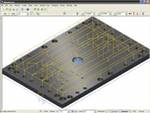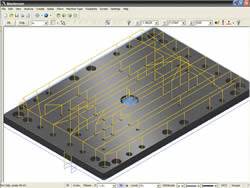Three Reasons to Maintain Your CAD/CAM
Maintain Your CAD/CAM Software, like any tool in the shop, needs maintenance.
It’s easy to understand why machine tools, measurement devices, vehicles, and other such “hardware” need to be maintained. Regular maintenance keeps them operating efficiently and helps them last as long as possible. One might not take the same logical leap when considering software because it keeps running pretty well, right? It doesn’t seem to need fixing or replacing, at least until the next major update is released and maybe not even then. However, like any other tool in the mold shop, software should be regularly maintained, and there are three compelling reasons for doing so.
1. Take Advantage of the Latest Technology
In between significant updates, most software developers continually improve the current version. They enhance the program, offering users the opportunity to always possess the latest technology to apply to their operations. Perhaps it’s a functionality improvement, a workflow enhancement, or a certain productivity tweak to take advantage of the latest technology in machine tools or cutting tools that will help a shop stay current in this highly competitive segment of the industry.
As a case in point, one such software package1 has included tooling libraries for some time now, but a significant new feature was just added that maintenance customers will automatically receive in their software update. This is of special interest to moldmakers who machine pre-hardened steels and those who machine many pockets and cavities over time.
Collaboration between software and cutting tools suppliers yields great benefits. One such collaboration2 involved getting the greatest productivity out of a line of chatter-free cutting tools—which need to be used in a particular way for true
high-efficiency machining—with the use of a software release that includes a “no fail” CNC programming approach when using these tools, so that users can apply the tools in the most optimum way to realize the greatest benefit.
2. Make Budget Planning Smoother
Another advantage of software maintenance is that it helps with fiscal planning. Maintenance customers know well in advance what the annual expenditure will be so they can budget for it. Before maintenance programs evolved, people would buy the major updates when they became available. Those were impossible to plan around since the customer would not necessarily know when the new software release happened and often the time wasn’t optimum to make the purchase for a host of valid reasons. Users would sometimes delay the acquisitions or pass on them altogether to allow time to gather the funding, meet with a steering committee, or embark on a justification process. In reality, it can be more expensive to purchase updates than to purchase an annualized maintenance program, when you factor in the time and personnel involved.
Software users can expect to get good value all through the year with a “once and done” approval step during the budget planning process. It’s inexpensive when you amortize it over the time being used, plus again, maintenance customers enjoy productivity gains in real time.
Often when customers purchase maintenance programs, the significant updates are included as well, which saves them even more. Say, for example a user springs for the major update every 10 years, and it costs the same as if he had the maintenance program over the course of the same 10 years. It’s the same dollar figure, but what did his mold shop lose over those 10 years in terms of productivity and profitability? I would argue that his company would have lost a lot.
3. Help Improve the Software
Customers who are on maintenance programs are typically vocal, which most credible developers view as a positive exchange. They voice their likes and dislikes, and offer helpful suggestions that could appear in the next release. Their feedback spurs the developer to continuously improve the package. Customers on maintenance believe they have more of a stake in the program, and they do.
Those who buy the software just once rarely communicate with the developer, and thereby lessen the value of their investment. The developer can never gain from their feedback and enrich the product in a certain way that might be a boon to thousands of others. In essence, people on maintenance help developers determine the direction of the software. It’s a bi-directional relationship that benefits the entire user group.
Yes, the same maintenance logic can leap from hardware to software. It’s like any other tool in the shop.
Footnotes:
1Mastercam/CNC Software
2Iscar Metals, Inc. and Mastercam/CNC Software.
Read Next
The Many Dimensions of Feature-Based Machining
Simple does not mean minimal. FBM is a powerful tool that can save many different types of users’ time and money. Here’s why.
Read MoreHow to Use Strategic Planning Tools, Data to Manage the Human Side of Business
Q&A with Marion Wells, MMT EAB member and founder of Human Asset Management.
Read MoreReasons to Use Fiber Lasers for Mold Cleaning
Fiber lasers offer a simplicity, speed, control and portability, minimizing mold cleaning risks.
Read More.jpg;maxWidth=970;quality=90)














.jpg;maxWidth=300;quality=90)






